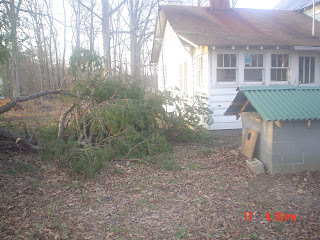
My youngest boy Lee purchased a house back during the summer. It was in a mature woodlot. Since then there has been 4 trees that have fallen. Two smaller trees were destroyed in the process. This latest downed tree, shown in these two pictures, was actually touching the house. The other 3 were not that surprising. They were decayed, leaning, and recently exposed to wind throw. The only problem with this pine was recent exposure and perhaps a restricted root zone. (I still haven't decided if there was an old road or just a terrace on the back side of this tree.) It was a severe wind that brought it down. In nearby towns, the power was knocked out to thousands of people. Hope this is the last one for awhile. There are only two or three real threats to the house and they look in fairly good shape. There is a white oak that could cause problems. It has a natural lean and would create a glancing blow to the house if it went that way.

































